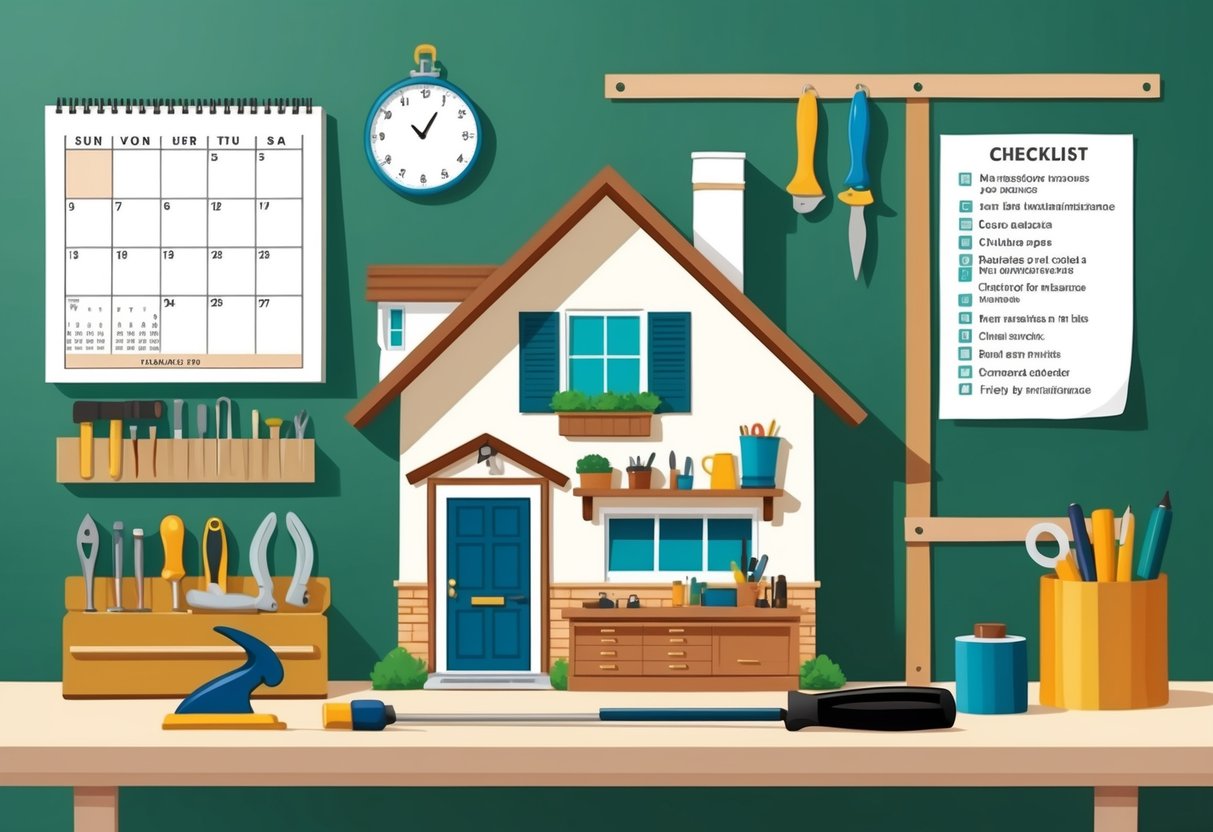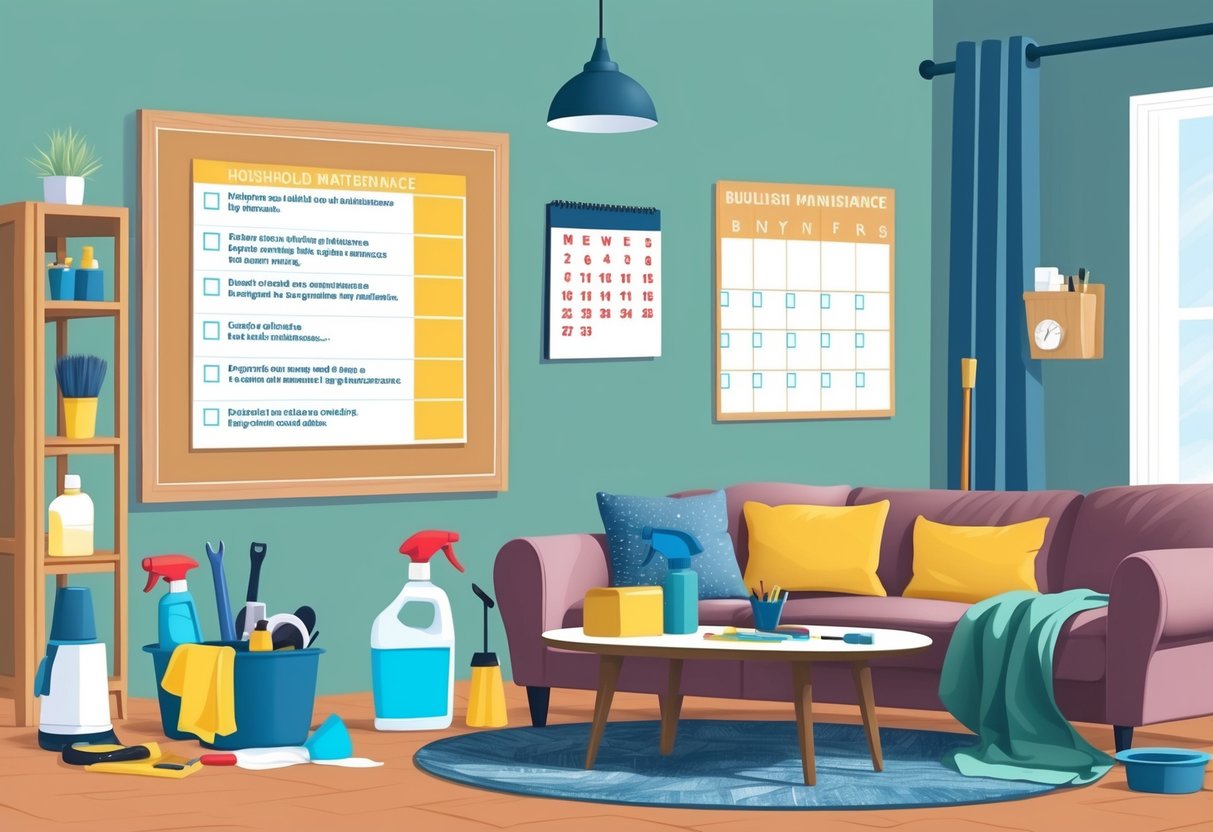
Monthly and Seasonal Home Maintenance Strategies
Targeted monthly and seasonal home maintenance tasks help prevent small issues from turning into expensive problems. Focusing on climate-specific actions, seasonal adjustments, and preparing for extreme conditions protects a home’s value and comfort.
Weather and Climate-Specific Tasks
A home’s local climate shapes the most urgent tasks on a regular maintenance schedule. In humid regions, checking for mold, ensuring effective ventilation, and cleaning air conditioning filters monthly are a priority.
In drier climates, inspecting exterior paint and sealants helps prevent cracking caused by sun exposure. Snow-prone areas demand monthly checks of roof integrity and insulation during colder months to reduce ice dam formation.
For homes in hurricane or tornado zones, it is crucial to review the security of windows, doors, and outdoor structures each month. This approach adapts maintenance to typical weather risks and seasonal maintenance needs.
Adjusting Maintenance for Changing Seasons
Every season brings distinct challenges that require timely maintenance. In spring, gutters should be cleared of debris, HVAC systems inspected, and windows checked for leaks.
During summer, tasks shift to servicing air conditioning units, checking outdoor faucets, and cleaning exhaust fans. Fall is a key time for roof inspections, heater tune-ups, and sealing air leaks.
Winter maintenance focuses on insulating exposed pipes, inspecting fireplaces, and ensuring smoke and carbon monoxide detectors are working properly. Comprehensive recommendations for these monthly and seasonal tasks can be found in home maintenance checklists designed for each season.
Preparing Your Home for Extreme Conditions
Extreme weather calls for extra preparedness in a preventative maintenance plan. Homes exposed to heavy storms should have emergency kits, test sump pumps, and secure loose exterior items each month.
For fire-prone areas, creating defensible space by clearing brush around the property and checking fire extinguishers is essential. Before winter storms, weatherstripping doors and windows, and stocking up on supplies like salt or sand protects the home and its occupants.
Regularly testing backup power sources and reinforcing vulnerable structures is important for homes in areas facing hurricanes or tornadoes. These strategies support long-term savings and safety during severe conditions.
Key Annual Home Maintenance Projects
Regular annual home maintenance helps prevent costly repairs and preserves home value. Careful attention to exterior systems like gutters, lawns, and irrigation ensures that structural damage and utility losses are minimized.
Gutter Cleaning and Inspection
Gutter cleaning and inspection is one of the most critical seasonal maintenance tasks. Debris such as leaves, twigs, and sediment must be removed to prevent water overflow that can damage siding, foundations, and landscaping.
Blocked gutters create the risk of ice dams in colder regions, causing leaks and expensive repairs. Homeowners should use a stable ladder and wear gloves when cleaning gutters.
Check for signs of sagging, leaks, or rust, and ensure downspouts clear water at least five feet from the foundation. After cleaning, check that water flows freely and inspect brackets and fasteners for corrosion or instability.
Making gutter care a yearly habit reduces the possibility of water intrusion and contributes to long-term home protection and cost savings. More tips and checklist recommendations can be found in this ultimate home maintenance guide.
Lawn Care and Landscaping Evaluations
Annual evaluations of lawn care and landscaping protect property value and help create a healthy outdoor environment. Tasks should include aerating the lawn, reseeding thin areas, fertilizing appropriately, and checking for weeds or pest infestations.
Mulching garden beds and pruning shrubs or trees, especially if they overhang roofs or powerlines, reduces damage from storms and improves curb appeal. Inspecting hardscaping—walkways, driveways, and patio areas—prevents trip hazards and water pooling.
Assessing plant health can also reveal drainage problems or diseased specimens. Routine care keeps grass vibrant and landscaping features well-maintained, making the home more attractive and resilient against common outdoor issues.
Checking the Irrigation System
A yearly inspection of the irrigation system is essential to maintain both lawns and landscape beds. Begin by running each irrigation zone individually, looking for clogged, leaking, or misaligned sprinkler heads.
Adjust heads to avoid overspray onto driveways, foundations, or street surfaces, as this can erode surfaces and waste water. Test the system for proper water pressure and timing.
Replace worn seals or cracked pipes, and clean filters as needed. Winterize exterior faucets and irrigation lines before freezing weather to avoid expensive burst pipes.
Scheduling repairs promptly and making enhancements such as adding a rain sensor improves efficiency and conserves water. For a detailed checklist, see this year-round home maintenance guide.
Addressing Common Household Issues Early

Catching issues early greatly reduces repair costs, improves safety, and protects property value. Quick attention to small problems, from pest invasion to water leaks, can prevent larger, more expensive headaches.
Preventing Pest Infestations
Keeping pests out requires routine diligence. Homeowners should inspect common entry points such as door frames, windows, attic vents, and cracks in the foundation.
Sealing gaps with durable caulking or weather stripping blocks ants, termites, and other insects from entering. Regularly cleaning kitchen areas, storing food in airtight containers, and disposing of garbage frequently reduces the chance of attracting pests.
Moisture is another key factor: pests like ants and termites are drawn to damp wood, so addressing any plumbing leaks or condensation helps maintain a pest-free environment. Seasonal pest inspections by professionals help detect hidden issues.
For more insights on creating a targeted schedule for routine preventative home maintenance, homeowners can benefit from expert checklists designed to catch pest risks before infestations take hold.
Mitigating Water Issues
Unchecked water problems are a common cause of structural and health damage. Homeowners should regularly check for leaks under sinks, around toilets, and behind appliances such as water heaters and washing machines.
Signs of mold, damp smells, and discoloration on walls or ceilings are indicators of hidden water issues. Clearing gutters and downspouts at least twice a year deters roof leaks and water damage to the foundation.
Ensuring grading around the home slopes away from the structure helps prevent water from pooling near the foundation. A leak in a pipe or appliance should be fixed immediately to avoid wood rot, foundation cracks, and mold growth.
Investing early in water mitigation steps saves significant money and avoids costly restoration projects down the line.
Managing Small Repairs Promptly
Small home repairs, when handled quickly, can stop bigger issues from developing. Tightening loose handrails, replacing worn weather stripping, and repairing damaged screens are simple actions that prevent injuries and keep pests and water out.
Regularly testing and changing HVAC filters, smoke detector batteries, and checking GFCI outlets ensures systems function safely and efficiently. Many homeowners follow a home maintenance checklist to keep up with recurring tasks.
Ignoring a minor problem, such as a cracked tile or sticking door, may lead to more complex repairs. Addressing these early reduces long-term costs and maintains a safe, comfortable living environment.